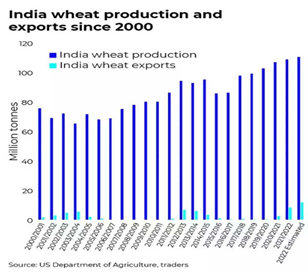

|
Overview
|
Context
India recently prohibited wheat exports, alleging a risk to food security, possibly due to the war in Ukraine and a searing heatwave that reduced productivity and caused local prices to reach a high record.
Analysis
India’s agricultural export
- India is a major agricultural commodity exporter in the globe. During 2021-22, the country crossed US$ 50 billion in agriculture exports with a 19.92% increase from US$ 41.87 billion in 2020-21.
- It exports rice, meat, grains, wheat, nuts, onions, fruits, pulses, dairy products, alcoholic beverages, cereals, cashews, vegetables, etc.
- Rice is India's largest exported agricultural crop, accounting for more than 17% of overall agricultural exports in 2021-22.
- Buffalo meat, wheat, and maize are among the largest exported products with the contribution of 6%, 4%, and 2% to 2021-22 agriculture exports respectively.
- The main importers of Indian agricultural goods are the United States, China, Bangladesh, the United Arab Emirates, Nepal, Iran, Saudi Arabia, Vietnam, Indonesia, and Malaysia.
- The other importing countries are Korea, Japan, Italy and the UK.
Recent Agricultural export statistics:
- Wheat: India is the world's second-largest wheat producer after China. Although India is not a large wheat exporter, its proportion has increased to 5%, up from 0.3% in 2019-20.
- Rice: India's proportion in global rice exports has climbed from around 22% in 2018-19 to 40% in 2021-22.
- Sugar: India's proportion of sugar exports has climbed to more than 11% from 3.4% in 2017-18.

Global Agricultural Trade:
- The World Bank predicts that food costs will climb by 22.9% this year, mostly due to a 40% increase in wheat prices.
- Primarily because Russia and Ukraine account for around 14% of world wheat output and 29% of total wheat exports.
- India is a major provider of wheat to its neighbors. Aside from Afghanistan, which recently got major shipments of wheat from India on humanitarian concerns, Bangladesh is another significant importer of Indian wheat.
- During 2021-22, India produced over 7 million tons of wheat, of which roughly 50% was imported by Bangladesh.
- Food protectionism:
- Indonesia began limiting palm oil exports, a prominent component discovered in many of the world's foods, cosmetics, and home products. It is the world's largest manufacturer of this commodity.
- Egypt has restricted exports of vital necessities such as wheat, lentils, flour, and beans due to increasing concerns over food supplies in the Arab world's largest economic state.
India and WTO:
- India's agricultural exports are under intense scrutiny by the World Trade Organization (WTO).
- In 2019, Brazil, Australia, and Guatemala protested to the WTO's dispute settlement committee that the Indian government was launching a number of subsidy schemes to boost sugar exports.
- The complainants said that by adopting these subsidy programs, the government had breached the terms of the WTO's Agreement on Agriculture (AoA), which prohibits the use of export subsidies.
- In December 2021, the dispute resolution panel that was handling the matter ruled against India.
- Several nations, including Russia, Japan, and the United States, have asked India to clarify if its food grain exports are tied to the Food Corporation of India's Open Market Sales Scheme.
|
WTO's Agreement on Agriculture:
|
Important Government Intervention
- Financial Assistance Scheme: FAS is an export marketing plan run by the Agriculture and Processed Food Products Export Development Authority (APEDA). It attempts to help firms build export infrastructure, quality, and market opportunities.
|
APEDA
|
- Agriculture Export Policy: The Agriculture Export Policy, which was implemented in 2018, focuses on export promotion, agriculture export-oriented production, increased farmer realization, and alignment with the Government of India's policies and initiatives.
- Agri-clusters: Agri-clusters have been active by organizing cluster-level committees, establishing FPOs, linking exporters to FPOs, and resolving transportation/logistics/packaging concerns, among other things.
- Farmer Connect Portal: A Farmer Connect Portal has been set up through APEDA for providing a platform for FPOs/FPCs, cooperatives to interact with exporters.
- Digital platforms: Several digital platforms for traceability, such as HortiNet for mango, vegetables, and citrus fruits, net, TraceNet for organics, Peanut.net, farm registration app, Meat.net, and Grapenet, have been developed to ensure the smooth flow of business and disclosure in the system.
- TMA Scheme: 'Transport and Marketing Assistance (TMA) for Specified Agriculture Products' is a scheme for providing assistance for the international component of freight to mitigate the freight disadvantage for the export of agriculture products and assistance for the marketing of agricultural produce.
Required measures
To become a leading global exporter, the country must handle the following aspects of the agri-food supply chain:
- Agri-production practices
- Supply chain and logistics
- Streamlining regulatory compliance practices
- Delivering transparency and traceability using technology
- Developing products suited to the global palate.
Conclusion
India's restriction on wheat exports has dealt a further blow to global markets, which are already struggling with restricted supplies due to output concerns in traditional production powerhouses Canada, Europe, and Australia, as well as clogged supply lines in the war-torn Black Sea region. However, India is a crucial supplier of wheat to its neighbours, and the Indian government is committed to ensuring the food security of neighbours and vulnerable countries.
|
PRACTICE QUESTION Q1. What are the hurdles to increasing India's agriculture exports? Suggest reform initiatives to increase agriculture exports. Q2. The agriculture industry is crucial to India's long-term prosperity and food security. Discuss the efforts made to revive the agricultural economy. |

